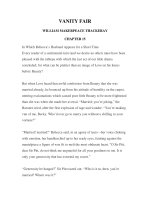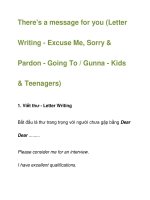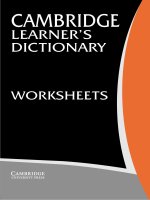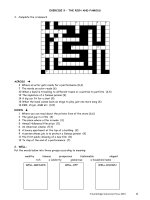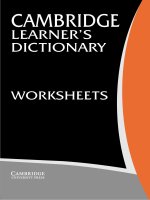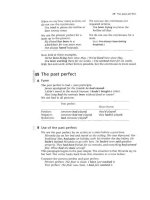Learner''s Material - let''s Explore Science For Daily Use
Bạn đang xem bản rút gọn của tài liệu. Xem và tải ngay bản đầy đủ của tài liệu tại đây (10.83 MB, 180 trang )
DRAFT
April 10, 2014
0
3
3
DRAFT
April 10, 2014
1
Book Record
School:
District:
Division:
Region:
Date received by school:
Issued to
(Name of Pupil)
Date
Issued
Condition
Date
Returned
Condition
To the Teacher
Write the pupil’s name clearly under the column “Issued to.”
Use the following letters in recording the condition of the book:
A. (New Book)
B. (Used Book in Good Condition)
C. (Used Book in Fair Condition)
D. (Used Book in Poor Condition)
Encourage and assist the pupil in repairing damaged textbooks.
DRAFT
April 10, 2014
2
Take Care of Your Book
Dos:
1. Cover your book with plastic or manila paper.
Old newspapers and magazines will do.
2. Be sure your hands are clean when you handle or turn the
pages.
3. When using a new book for the first time, lay it on its back.
Open only a few pages at a time. Press lightly along the
bound edge as you turn the pages. This will keep the cover
in good condition.
4. Use a piece of paper or cardboard for bookmarks.
5. Paste or tape immediately any torn pages.
6. Handle the book with care when passing from one person
to another.
7. Always keep your book in a clean, dry place.
8. When your book is lost, report it to your teacher right away.
Don’ts:
1. Do not fold the pages.
2. Do not write on the cover or pages.
3. Do not cut out any picture.
4. Never tear or detach any page.
DRAFT
April 10, 2014
3
For inquiries or feedback, please write or call:
DepEd-Bureau of Elementary Education
Curriculum Development Division
2
nd
Floor, Bonifacio Bldg., DepEd Complex (ULTRA)
Meralco Avenue, Pasig City, Philippines 1600
Telefax: (632) 638-4799 or 637-4347
E-mail Address:
DRAFT
April 10, 2014
4
INTRODUCTION
Dear Boys and Girls:
This Learner’s Material for Grade 3, was written in
response to the basic goal of education under the K to12
Enhanced Basic Education Program- “to prepare learners to
become productive, worthy and competitive young
scientists of the country.”
This is divided into four units with illustrations describing
each unit, representing the whole school year. Each unit has
chapter with lessons and activities prepared which are
aligned to the teacher’s guide.
Learning to develop, keen and accurate observation
skills through experiment, knowing more about matter, sense,
living things, non-living things around you discovering more
about your environment , climate change and other topics
about the surroundings, earth and space are all given focus
in this l learner’s material.
Explore Science and make it useful in your daily life.
Learning Science is having more fun.
The Writers/Conceptualizers
DRAFT
April 10, 2014
5
ACKNOWLEDGEMENT
Recognition is given to the following supervisors,
administrators, teachers, BEE Staff and experts in Science for their
enthusiastic commitment in the development, revision and
finalization of the teaching guides and learning materials for Grade
3 under K to 12 Basic Education Program.
Arthur DC. Sacatropes Dr. Luz E. Osmena
Education Prog. Supervisor Education Prog. Supervisor
Region III Region IV-A
Michelle G. Hatid-Guadamor, Ph.D. Aiisa C. Corpuz
Education Program Supervisor Science Coordinator
Division Office, Sorsogon Prov. Division of Tarlac City
Region V Region III
Jennifer M. Rojo Jennifer A. Tinaja
Master Teacher II MasterTeacher I
Neogen Elementary School Nueve de Febrero E.S.
Districtof Tagaytay City Mandaluyong City
Job S. Zape (Ret.) John Fitzgerald Secondes
Education Program Supervisor Master Teacher I
Division Office, Mandaluyong City Don Felix Serra Nat’l. Hi-sch
San Jaoquin, Iloilo Province
Leni S. Solutan Neolita S. Sarabia
Master Teacher Principal II
Sta. Barbara Elementary School STRIVE Coordinator
Division of Iloilo Province Division of Tagbilaran City
Romeo C. Ordoňez
Master Teacher II/Illustrator
Divisoria E.S. Mexico South District
Division of Pampanga
Susana D. Mota
Jemmalyn N. Malabanan
Encoders
DRAFT
April 10, 2014
6
Appreciation is extended to the following consultants/reviewers
for their untiring efforts in sharing their expertise:
Evelyn L. Josue
Science Educ. Specialist IV (Ret.)
UP-NISMED
Diliman, Quezon City
Pia Campo May R. Chavez
Science Educ. Specialist Science Educ. Specialist
UP-NISMED UP-NISMED
Diliman, Quezon City Diliman, Quezon City
Trinidad M. Lagarto
Senior Educ. Prog. Specialist, Anchorperson
Curriculum Development Division
Bureau of Elementary Education
Marilette R. Almayda
Director III
Bureau of Elementary Education
Marilyn D. Dimaano
Director IV
Bureau of Elementary Education
DRAFT
April 10, 2014
7
TABLE OF CONTENTS
Page
Title Page i
Book Record for the Teacher ii
Copyright Page iii
How to take care of your Book iv
Introduction v
Acknowledgement vi
UNIT I: Matter
Overview
Chapter 1 – Solids 11-17
- Characteristics of Solids
- Naming /Classifying Different Solids
- Describing Solids according to Color
- Describing Solids according to Shape
- Describing Solids according to Size
- Describing Solids according to Texture
Chapter 2 – Liquids 17-23
- Characteristics of Liquids
- Naming /Classifying Different Liquids
- Describing Liquids according on how they flow
- Describing Liquids on how they take the
Shape of the container
- Describing Liquids on how they occupy Space
- Describing Liquids according to Smell
Chapter 2 – Gases 23-26
- Describing that Gases take the Shape of the Container
- Describing that Gases occupy Space
- Describing that Gases are Odorless and Tasteless
DRAFT
April 10, 2014
8
Chapter 4 – Proper Use and Handling of Common Solids, 26-31
Liquids, and Gases at Home and in School
- List of Common Products Found at Home and in School
- Harmful Effects of Common Materials Found
at Home and in School
- Safety Measures in handling Harmful Materials
Chapter 5 - Changes in Materials 31-49
- Measuring the Temperature of Materials
- Measuring the Temperature of Hot/Warm Materials
- Measuring the Temperature of a Cold Material
- Changes in Materials as affected by Temperature
- What happens to Water when Heated?
- What happens to Water Vapor when Cooled?
- What happens to Napthalene Ball when Heated?
- What happens to the Air inside the Bottle/Balloon when
Heated or Cooled?
UNIT 2: Living Things and their Environment
Chapter 1 - Sense Organs 51-66
- Identifying the Parts of the Eyes
- Proper Ways of Caring the Eyes
- Identifying the Parts of the Ears
- How the different Parts of the Ear Work?
- Proper Ways of Caring the Ears
- Identifying Parts of the Nose and its Functions
- Proper Ways of Caring the Nose
- Identifying the Uses of Tongue
- Identifying the Parts and Functions of the Tongue
- Identifying the parts of the Skin and its Function
- Proper Ways of Caring the Skin
Chapter 2 – Animals 67-86
- Naming Animals around you
- Parts of an Animal
- Body Parts Animals Use to Move
- Classifying Animals according to how they move
- Body Parts of Animals that they use in getting foods
DRAFT
April 10, 2014
9
- Classifying Animals according to what they Eat
- Classifying Animals according to their Body Covering
- Classifying Animals according to their Habitat
- Useful Animals
- Importance of Animals according to Use
- Animals that can Harm People
- Proper Ways of Caring Pets
Chapter 3 – Plants 87-101
- Naming and Describing Plant Parts
- Same Plant Parts, different Plants
- Different Plant Parts have different Works
- Things that come from or made of Plants
- Different Uses of Plants
- Harmful Plants
- Proper Was of Caring Plants
- Characteristics of Living and non-living Things
Chapter 4 - Heredity: Inheritance and Variation 101-108
- Animals Produce Animals of the same Kind
- Physical Traits of People from Different Ethnicity
- Physical Traits of Animals of the same Kind
- Plants Produce Plants of the same Kind
- Growing Plants from other Plant Parts
Chapter 5 - Ecosystem 109-115
- Basic Needs Humans, Animals and Plants
- Things We Need from the Environment
- Conservation and Protection of the Environment
UNIT 3: Force, Motion and Energy
Chapter 1 - Moving Objects 116-130
- Describing the Position of an Object
relative to another Object
- Describing the Location of Objects After it is Moved
- Sounds
DRAFT
April 10, 2014
10
Chapter 2 - Electricity 145-151
- Sources of Electricity
- Uses of Electricity
UNIT 4: Earth and Space
Chapter 1 - Surroundings 151-162
- The Surroundings
Chapter 2: Weather 162-178
- The Weather
Chapter 3: Objects Seen in the Sky 178-188
- Different Objects seen in the Sky
DRAFT
April 10, 2014
11
UNIT 1: Matter
DRAFT
April 10, 2014
12
Chapter 1: Solids
This Chapter deals with solid as one of the three states
of matter. It has specific color, size, shape, and texture. The
particles of solids are close together. They move back and
forth but the particles do not change places.
Lesson 1: Characteristics of Solids
Activity 1: What are the characteristics of solids?
Objectives
1. Describe different objects in the school garden
2. Classify the objects based on their characteristics
Materials
Different objects found in the school garden
Procedure
1. Visit the school garden. Collect different solids.
2. List down 10 solids you have collected.
3. Describe the solids based on their characteristics
4. In the chart write the name of solids in their proper
column. Do this in your notebook.
small
big
rough
smooth
round
square
black
white
In your notebook or on your paper, answer the following:
1. How did you describe the solids?
2. What are their characteristics?
Guide Question
What are the other properties of matter?
DRAFT
April 10, 2014
13
Lesson 2: Characteristics of Solids according to Color
Activity 2: How do you describe solids according to their
colors?
Objective
Describe solids according to their color
Materials
Pictures and if possible concrete ripe papaya, unripe
papaya, ripe mango, unripe mango, ripe tomato, unripe
tomato, eggplant and charcoal
Procedure
1. Study the pictures of different solids.
2. Write the color of solid in the chart.
Solids
Color
Ripe Mango
Unripe Tomato
Ripe Tomato
Unripe Papaya
DRAFT
April 10, 2014
14
Ripe Papaya
Watermelon
Eggplant
Charcoal
In your notebook, answer the following:
1. How did you describe the materials?
2. Do all solids have specific color?
Lesson 3: Characteristics of Solids according to Shape
Activity 1: Shapely solids
Objective
Identify solids based on their shape
DRAFT
April 10, 2014
15
Materials
ball, eraser, calamansi, plate, guava, notebook,
triangle (musical instrument)
Procedure
1. Get six objects from the box.
2. Observe the shape of the objects.
3. Write the name of each object below their
corresponding shape.
Round
Rectangle
Triangle
In your notebook, answer the following:
1. How did you identify solids based on their shape?
2. What different shapes of solids did you observe?
Lesson 4: Characteristics of Solids according to Size
Activity 1: Identify solids according to size
Objectives
1. Identify solids according to their specific size
2. Measure solids using a ruler
DRAFT
April 10, 2014
16
Materials
bag containing solids Ruler
Procedure
1. Get the materials inside your bag.
2. Identify solids according to their sizes.
3. Record it in your notebook.
Materials/Solid
Size
big
small
1. Measure each solid using a ruler.
2. Record your measurement in your notebook.
Solids
Size (exact measurement)
Answer the following:
1. How did you identify the size of solids?
2. What did you use to measure the material?
3. Were you able to get the exact measurement of the
solids? How?
Guide Question
Do solids have specific size?
Lesson 5: Characteristics of Solids according to Texture
Activity 1: Classifying solids according to texture
Objective
Classify solids according to texture.
DRAFT
April 10, 2014
17
Materials
bag or box containing stone, cotton, sand, banana,
cardboard, sandpaper, rambutan, jackfruit peelings
Procedure
1. Get all the contents of your bag.
2. In your notebook, write the name of each object and
classify according to texture.
Objects
smooth
rough
soft
hard
Answer the following:
1. How did you group the solids?
2. What characteristic of solids did you observe?
3. Were you able to describe the solids correctly based
on your observations? Why?
4. What values did you learn from the activities?
Chapter 2: Liquids
This Chapter deals with liquids having mass, how they
flow, how they take the shape of the container, how they
occupy space, the taste and the smell.
Lesson 1: Characteristics of Liquids
Activity 1: Naming different liquids
DRAFT
April 10, 2014
18
Objective
Naming different liquids
Materials
different liquids, containers with different shapes
Procedure
1. Go to the school canteen.
2. Ask the canteen staff to show the different liquids
available.
3. Name each liquid.
4. Observe each liquid how they flow , shape of the
container, and the space each occupies.
5. Taste or smell the liquid but with safety precaution.
(Needs teacher’s advice.)
6. Record your observation in your notebook.
Lesson 2: Describing Liquids according on How they Flow
Activity1: How do liquids flow?
Objective
Describe how liquids flow
Materials
condensed milk, soy sauce, vinegar, shampoo, water
oil, 2 spoons, transparent bowl
Procedure
1. Get two teaspoons.
2. Hold each teaspoon with each hand as shown in the
picture below.
DRAFT
April 10, 2014
19
3. Scoop a teaspoon of water and a teaspoon of vinegar.
4. Hold two teaspoons with liquids at elbow level.
5. Tip both hands at the same time as shown in the
picture.
6. Record your observation in your notebook.
Which flows faster, water or vinegar?
7. Repeat steps 2 to 6 using other liquid and paired it with
water.
(Note: Water will serve as your point of reference as to
the flow of liquid.)
Name of
Liquid
Does it flow
slowly?
Does it flow
fast?
Does it flow
very fast?
1. water
2. soy sauce
3. vinegar
4. shampoo
5. oil
6. Condensed
milk
Guide Questions
1. Did the liquids flow at the same time?
2. Which liquids flowed fast?
3. Which liquids flowed slow?
Lesson 3: Describing Liquids on How They Take the Shape of
the Container
Activity 1: Do liquids have shape?
DRAFT
April 10, 2014
20
Objective
Describe how liquids take the shape of the container
Materials
different shapes of container, water
Procedure
1. Describe the 3 shapes of container.
2. Get 3 kinds of liquids.
3. Pour each liquid in each container.
4. In your notebook, record your observation.
Name of Liquid
Shape when poured in container
1.What happened to the different liquids after pouring them
2. Do liquids have the same shape?
3. What characteristics of liquids did you observe?
4. What does this activity tell about shape of liquid?
Lesson 4: Describing Liquids on How they Occupy Space
Activity 1: Do liquids occupy space?
Objective
Describe how liquids occupy space.
Materials
stones, water, beaker, rugs
Procedure
1. Prepare the materials.
2. Fill the beaker with water.
3. Put more water in the beaker.
DRAFT
April 10, 2014
21
4. Observe what happens while adding more water in
the beaker.
5. Put some stones in the beaker with water.
6. Again observe what will happen.
7. Record /draw your observation in your notebook.
In your notebook, answer the following:
1. What happened as you added more and more water
in the beaker? Why?
2. What did you notice when the stones sank to the
bottom of the beaker? Why?
3. What happened to the water? Why?
4. Does water occupy space? Why?
5. Do liquids really occupy space?
Lesson 5: Describing Liquids according to Taste
Activity 1: Do liquids have taste?
Objective
Describe the taste of liquids.
Materials
milk, juice, water, vinegar, hot sauce, softdrinks, wine,
catsup, fish sauce
Procedure
1. Taste each liquid.
2. Describe the taste.
3. Check the corresponding taste of liquid in the chart.
Liquid
sweet
salty
sour
bitter
spicy
tasteless
DRAFT
April 10, 2014
22
In your notebook, answer the following:
1. How did you describe the different taste of liquids?
2. What are the different tastes of liquids?
3. Do all liquids have the same taste?
4. What should we do to avoid being poisened when tasting
liquids?
Lesson 6: Describing Liquid according to Smell
Activity 1: Do liquids have smell?
Objective
Describe the smell of different liquids
Materials
fish sauce, perfume, alcohol, catsup, coke, hand
sanitizer, shampoo, liquid soap
Procedure
1. Prepare the materials. Name the different liquids.
2. Describe the smell of the different liquids. (Do not put the
samples near your nose because some may cause irritation)
3. Record your observation.
Liquid
Bad Smell
Good / Fragrant Smell
In your notebook, answer the following:
1. What characteristics of liquid did you observed?
2. How were you able to group them?
3. Do all liquids have the same smell?
4. Do you frown when you smell liquids that have bad odor?
Do you smile when you smell liquids that have fragrant
odor? Why?
5.Do liquids have smell?
DRAFT
April 10, 2014
23
Chapter 3: Gases
This Chapter, deals with gases that do not have their
own shape but take the shape of the container; occupy
space, tasteless and odorless. Air is gas. We cannot see it by
our eye but we can feel it. The molecules are far apart from
each other.
Lesson 1: Describing that Gases take the Shape of the
Container
Activity 1: Do gases have shape?
Objective
Describe that gases take the shape of the container
Materials
different shapes of balloons (deflated), string
Procedure
1. Get different shapes of balloons.
2. Blow air into it. Tie it with string.
3. Describe the shape of air in the balloon.
4. Record your observation.
5. Draw the shape of gas in each balloon.
Questions
In your notebook, answer the following:
1. What happened to the balloon as you blew air into it?
2. Did the gas follow the shape of the balloon? Do gases
have shape?
3. What characteristic of gas did the activity show?
4. What is the shape of air container?
5. When can air have a shape?
DRAFT
April 10, 2014
24
Lesson 2: Describing that Gases Occupy Space
Activity 1: Does gas occupy space?
Objective
Describe that gases occupy space
Materials
tissue, drinking glass, Styrofoam, big bowl filled with full
of water
Procedure
1. Prepare a drinking glass.
2. Place a paper towel at the bottom of a drinking glass
so that it will not fall out when the glass is inverted.
3. Fill a big bowl with water.
4. Hold the glass upside down and quickly plunge it into
the water.
5. Count one to ten while holding the glass underwater.
6. Slowly lift the glass up and out of the water. Be sure to
hold the glass straight upside down.
7. Observe. What happened to the tissue?
8. Do this with a piece of Styrofoam. Place the Styrofoam
in the water. Place your glass upside down over the
styrofoam and push straight down into the water.
In your notebook, answer the following:
1. What is inside the glass?
2. What happened to the paper towel? To the styrofoam?
3. What does the activity show?


